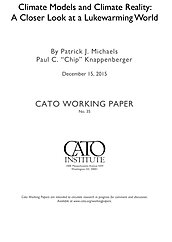The case for lukewarming — modest anthropogenic climate change in accordance with the lower end of expectations from mainstream science — is simple, straightforward, and compelling.
It is readily demonstrated that the rate of warming that has taken place over the past several decades, both at the earth’s surface as well as is the lower levels of the earth’s atmosphere critical for the development of the world’s weather patterns, has been slower than what was anticipated by the large collection of the climate models — models developed specifically to simulate the behavior of the earth/atmosphere system under conditions of changing human inputs. Over some time periods, the observed rate of warming has been so slow as to have been completely unexpected by any of the climate models, a worrying indication that the current state-of-the-art climate models are not up to the task of simulating the actual behavior of the earth’s climate. If the known climate behavior cannot be well-captured by the models, no case can be made for the veracity of projections, from the same models, of the future evolution of our climate — the projections which underlie current climate/energy policy.
While myriad explanations for the apparent model/observations discord have been forwarded in the scientific literature, a most-compelling one is that the earth’s equilibrium climate sensitivity — how much the earth’s average surface temperature will rise with a doubling of the atmospheric concentration of the greenhouse gas carbon dioxide — is substantially lower than the value characteristic of the climate model collective. Evidence that the climate sensitivity lies towards the lower end of the range of possibilities given by consensus of mainstream science has been growing in recent years.
In this paper, we examine the data indicating a less-than-expected warming and a poor correspondence between climate model expectations and real-world observations. Further, we review the recent scientific findings in support of a low climate sensitivity. Based upon these and other lines of evidence (laid out in our numerous scientific publications, books, blogs articles, social media), we conclude that future global warming will occur at a pace substantially lower than that upon which US federal and international actions to restrict greenhouse gas emissions are founded.
It is high time to rethink those efforts.


